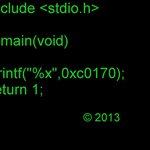mbed library sources
Dependents: Encrypted my_mbed lklk CyaSSL_DTLS_Cellular ... more
Superseded
This library was superseded by mbed-dev - https://os.mbed.com/users/mbed_official/code/mbed-dev/.
Development branch of the mbed library sources. This library is kept in synch with the latest changes from the mbed SDK and it is not guaranteed to work.
If you are looking for a stable and tested release, please import one of the official mbed library releases:
Import librarymbed
The official Mbed 2 C/C++ SDK provides the software platform and libraries to build your applications.
targets/hal/TARGET_Atmel/TARGET_SAM21/drivers/sercom/i2c/i2c_common.h
- Committer:
- mbed_official
- Date:
- 2015-07-17
- Revision:
- 592:a274ee790e56
- Parent:
- 579:53297373a894
File content as of revision 592:a274ee790e56:
#ifndef I2C_COMMON_H_INCLUDED
#define I2C_COMMON_H_INCLUDED
#include <compiler.h>
#include <sercom.h>
#ifdef __cplusplus
extern "C" {
#endif
/**
* \if (I2C_MASTER_MODE && I2C_SLAVE_MODE)
* \defgroup asfdoc_sam0_sercom_i2c_group SAM I2C Driver (SERCOM I2C)
* \elseif I2C_MASTER_MODE
* \defgroup asfdoc_sam0_sercom_i2c_group SAM I2C Master Mode Driver (SERCOM I2C)
* \elseif I2C_SLAVE_MODE
* \defgroup asfdoc_sam0_sercom_i2c_group SAM I2C Slave Mode Driver (SERCOM I2C)
* \endif
*
* This driver for Atmel庐 | SMART SAM devices provides an interface for the configuration
* and management of the device's SERCOM I<SUP>2</SUP>C module, for the transfer
* of data via an I<SUP>2</SUP>C bus. The following driver API modes are covered
* by this manual:
*
* \if I2C_MASTER_MODE
* - Master Mode Polled APIs
* \endif
* \if I2C_MASTER_CALLBACK_MODE
* - Master Mode Callback APIs
* \endif
* \if I2C_SLAVE_MODE
* - Slave Mode Polled APIs
* \endif
* \if I2C_SLAVE_CALLBACK_MODE
* - Slave Mode Callback APIs
* \endif
*
* The following peripheral is used by this module:
* - SERCOM (Serial Communication Interface)
*
* The following devices can use this module:
* - Atmel | SMART SAM D20/D21
* - Atmel | SMART SAM R21
* - Atmel | SMART SAM D10/D11
* - Atmel | SMART SAM L21
*
* The outline of this documentation is as follows:
* - \ref asfdoc_sam0_sercom_i2c_prerequisites
* - \ref asfdoc_sam0_sercom_i2c_overview
* - \ref asfdoc_sam0_sercom_i2c_special_considerations
* - \ref asfdoc_sam0_sercom_i2c_extra
* - \ref asfdoc_sam0_sercom_i2c_examples
* - \ref asfdoc_sam0_sercom_i2c_api_overview
*
* \section asfdoc_sam0_sercom_i2c_prerequisites Prerequisites
* There are no prerequisites.
*
* \section asfdoc_sam0_sercom_i2c_overview Module Overview
* The outline of this section is as follows:
* - \ref asfdoc_sam0_sercom_i2c_module_features
* - \ref asfdoc_sam0_sercom_i2c_functional_desc
* - \ref asfdoc_sam0_sercom_i2c_bus_topology
* - \ref asfdoc_sam0_sercom_i2c_transactions
* - \ref asfdoc_sam0_sercom_i2c_multi_master
* - \ref asfdoc_sam0_sercom_i2c_bus_states
* - \ref asfdoc_sam0_sercom_i2c_timeout
* - \ref asfdoc_sam0_sercom_i2c_sleep_modes
*
* \subsection asfdoc_sam0_sercom_i2c_module_features Driver Feature Macro Definition
* <table>
* <tr>
* <th>Driver Feature Macro</th>
* <th>Supported devices</th>
* </tr>
* <tr>
* <td>FEATURE_I2C_FAST_MODE_PLUS_AND_HIGH_SPEED</td>
* <td>SAM D21/R21/D10/D11/L21</td>
* </tr>
* <tr>
* <td>FEATURE_I2C_10_BIT_ADDRESS</td>
* <td>SAM D21/R21/D10/D11/L21</td>
* </tr>
* <tr>
* <td>FEATURE_I2C_SCL_STRETCH_MODE</td>
* <td>SAM D21/R21/D10/D11/L21</td>
* </tr>
* <tr>
* <td>FEATURE_I2C_SCL_EXTEND_TIMEOUT</td>
* <td>SAM D21/R21/D10/D11/L21</td>
* </tr>
* </table>
* \note The specific features are only available in the driver when the
* selected device supports those features.
*
* \subsection asfdoc_sam0_sercom_i2c_functional_desc Functional Description
* The I<SUP>2</SUP>C provides a simple two-wire bidirectional bus consisting of a
* wired-AND type serial clock line (SCL) and a wired-AND type serial data line
* (SDA).
*
* The I<SUP>2</SUP>C bus provides a simple, but efficient method of interconnecting
* multiple master and slave devices. An arbitration mechanism is provided for
* resolving bus ownership between masters, as only one master device may own
* the bus at any given time. The arbitration mechanism relies on the wired-AND
* connections to avoid bus drivers short-circuiting.
*
* A unique address is assigned to all slave devices connected to the bus. A
* device can contain both master and slave logic, and can emulate multiple
* slave devices by responding to more than one address.
*
* \subsection asfdoc_sam0_sercom_i2c_bus_topology Bus Topology
* The I<SUP>2</SUP>C bus topology is illustrated in
* \ref asfdoc_sam0_sercom_i2c_bus_topology_figure "the figure below". The pull-up
* resistors (Rs) will provide a high level on the bus lines when none of the
* I<SUP>2</SUP>C devices are driving the bus. These are optional, and can be
* replaced with a constant current source.
*
* \anchor asfdoc_sam0_sercom_i2c_bus_topology_figure
* \image html bus_topology.svg "I2C Bus Topology" Width=100%
*
* \subsection asfdoc_sam0_sercom_i2c_transactions Transactions
* The I<SUP>2</SUP>C standard defines three fundamental transaction formats:
* - Master Write
* - The master transmits data packets to the slave after addressing it
* - Master Read
* - The slave transmits data packets to the master after being addressed
* - Combined Read/Write
* - A combined transaction consists of several write and read transactions
*
* A data transfer starts with the master issuing a \b Start condition on the
* bus, followed by the address of the slave together with a bit to indicate
* whether the master wants to read from or write to the slave.
* The addressed slave must respond to this by sending an \b ACK back to the
* master.
*
* After this, data packets are sent from the master or slave, according to the
* read/write bit. Each packet must be acknowledged (ACK) or not
* acknowledged (NACK) by the receiver.
*
* If a slave responds with a NACK, the master must assume that the slave
* cannot receive any more data and cancel the write operation.
*
* The master completes a transaction by issuing a \b Stop condition.
*
* A master can issue multiple \b Start conditions during a transaction; this
* is then called a \b Repeated \b Start condition.
*
* \subsubsection asfdoc_sam0_sercom_i2c_address_packets Address Packets
* The slave address consists of seven bits. The 8<SUP>th</SUP> bit in the transfer
* determines the data direction (read or write). An address packet always
* succeeds a \b Start or \b Repeated \b Start condition. The 8<SUP>th</SUP> bit is handled
* in the driver, and the user will only have to provide the 7-bit address.
*
* \subsubsection asfdoc_sam0_sercom_i2c_data_packets Data Packets
* Data packets are nine bits long, consisting of one 8-bit data byte, and an
* acknowledgement bit. Data packets follow either an address packet or another
* data packet on the bus.
*
* \subsubsection asfdoc_sam0_sercom_i2c_trans_examples Transaction Examples
* The gray bits in the following examples are sent from master to slave, and
* the white bits are sent from slave to master.
* Example of a read transaction is shown in
* \ref asfdoc_sam0_sercom_i2c_trans_examples_i2c_read "the figure below". Here, the
* master first issues a \b Start condition and gets ownership of the bus. An
* address packet with the direction flag set to read is then sent and
* acknowledged by the slave. Then the slave sends one data packet which is
* acknowledged by the master. The slave sends another packet, which is not
* acknowledged by the master and indicates that the master will terminate the
* transaction. In the end, the transaction is terminated by the master issuing
* a \b Stop condition.
*
* \anchor asfdoc_sam0_sercom_i2c_trans_examples_i2c_read
* \image html i2c_read.svg "I2C Packet Read" Width=100%
*
* Example of a write transaction is shown in
* \ref asfdoc_sam0_sercom_i2c_trans_examples_i2c_write "the figure below". Here, the
* master first issues a \b Start condition and gets ownership of the bus. An
* address packet with the dir flag set to write is then sent and acknowledged
* by the slave. Then the master sends two data packets, each acknowledged by
* the slave. In the end, the transaction is terminated by the master issuing
* a \b Stop condition.
*
* \anchor asfdoc_sam0_sercom_i2c_trans_examples_i2c_write
* \image html i2c_write.svg "I2C Packet Write" Width=100%
*
* \subsubsection asfdoc_sam0_sercom_i2c_packet_timeout Packet Timeout
* When a master sends an I<SUP>2</SUP>C packet, there is no way of
* being sure that a slave will acknowledge the packet. To avoid stalling the
* device forever while waiting for an acknowledge, a user selectable timeout
* is provided in the \ref i2c_master_config struct which
* lets the driver exit a read or write operation after the specified time.
* The function will then return the STATUS_ERR_TIMEOUT flag.
*
* This is also the case for the slave when using the functions postfixed
* \c _wait.
*
* The time before the timeout occurs, will be the same as
* for \ref asfdoc_sam0_sercom_i2c_unknown_bus_timeout "unknown bus state" timeout.
*
* \subsubsection asfdoc_sam0_sercom_i2c_repeated_start Repeated Start
* To issue a \b Repeated \b Start, the functions postfixed \c _no_stop must be
* used.
* These functions will not send a \b Stop condition when the transfer is done,
* thus the next transfer will start with a \b Repeated \b Start. To end the
* transaction, the functions without the \c _no_stop postfix must be used
* for the last read/write.
*
* \subsection asfdoc_sam0_sercom_i2c_multi_master Multi Master
* In a multi master environment, arbitration of the bus is important, as only
* one master can own the bus at any point.
*
* \subsubsection asfdoc_sam0_sercom_i2c_arbitration Arbitration
*
* \par Clock stretching
* The serial clock line is always driven by a master device. However, all
* devices connected to the bus are allowed stretch the low period of the clock
* to slow down the overall clock frequency or to insert wait states while
* processing data.
* Both master and slave can randomly stretch the clock, which will force the
* other device into a wait-state until the clock line goes high again.
*
* \par Arbitration on the data line
* If two masters start transmitting at the same time, they will both transmit
* until one master detects that the other master is pulling the data line low.
* When this is detected, the master not pulling the line low, will stop the
* transmission and wait until the bus is idle.
* As it is the master trying to contact the slave with the lowest address that
* will get the bus ownership, this will create an arbitration scheme always
* prioritizing the slaves with the lowest address in case of a bus collision.
*
* \subsubsection asfdoc_sam0_sercom_i2c_clock_sync Clock Synchronization
* In situations where more than one master is trying to control the bus clock
* line at the same time, a clock synchronization algorithm based on the same
* principles used for clock stretching is necessary.
*
*
* \subsection asfdoc_sam0_sercom_i2c_bus_states Bus States
* As the I<SUP>2</SUP>C bus is limited to one transaction at the time,
* a master that wants to perform a bus transaction must wait until the bus is
* free.
* Because of this, it is necessary for all masters in a multi-master system to
* know the current status of the bus to be able to avoid conflicts and to
* ensure data integrity.
* \li \b IDLE No activity on the bus (between a \b Stop and a new \b Start
* condition)
* \li \b OWNER If the master initiates a transaction successfully
* \li \b BUSY If another master is driving the bus
* \li \b UNKNOWN If the master has recently been enabled or connected to
* the bus. Is forced to \b IDLE after given
* \ref asfdoc_sam0_sercom_i2c_unknown_bus_timeout "timeout" when
* the master module is enabled.
*
* The bus state diagram can be seen in
* \ref asfdoc_sam0_sercom_i2c_bus_states_figure "the figure below".
* \li S: Start condition
* \li P: Stop condition
* \li Sr: Repeated start condition
* \anchor asfdoc_sam0_sercom_i2c_bus_states_figure
* \image html bus_state_diagram.svg "I2C Bus State Diagram" Width=100%
*
* \subsection asfdoc_sam0_sercom_i2c_timeout Bus Timing
* Inactive bus timeout for the master and SDA hold time is configurable in the
* drivers.
*
* \subsubsection asfdoc_sam0_sercom_i2c_unknown_bus_timeout Unknown Bus State Timeout
* When a master is enabled or connected to the bus, the bus state will be
* unknown until either a given timeout or a stop command has occurred. The
* timeout is configurable in the \ref i2c_master_config struct.
* The timeout time will depend on toolchain and optimization level used, as
* the timeout is a loop incrementing a value until it reaches the specified
* timeout value.
*
* \subsubsection sda_hold SDA Hold Timeout
* When using the I<SUP>2</SUP>C in slave mode, it will be important to
* set a SDA hold time which assures that the master will be able to pick up
* the bit sent from the slave. The SDA hold time makes sure that this is the
* case by holding the data line low for a given period after the negative edge
* on the clock.
*
* The SDA hold time is also available for the master driver, but is not a
* necessity.
*
* \subsection asfdoc_sam0_sercom_i2c_sleep_modes Operation in Sleep Modes
* The I<SUP>2</SUP>C module can operate in all sleep modes by setting
* the run_in_standby Boolean in the \ref i2c_master_config or
* \ref i2c_slave_config struct.
* The operation in slave and master mode is shown in
* \ref asfdoc_sam0_sercom_i2c_sleep_modes_table "the table below".
*
* \anchor asfdoc_sam0_sercom_i2c_sleep_modes_table
* <table>
* <caption>I<SUP>2</SUP>C Standby Operations</caption>
* <tr>
* <th>Run in standby</th>
* <th>Slave</th>
* <th>Master</th>
* </tr>
* <tr>
* <td>false</td>
* <td>Disabled, all reception is dropped</td>
* <td>GCLK disabled when master is idle</td>
* </tr>
* <tr>
* <td>true</td>
* <td>Wake on address match when enabled</td>
* <td>GCLK enabled while in sleep modes</td>
* </tr>
* </table>
*
*
* \section asfdoc_sam0_sercom_i2c_special_considerations Special Considerations
*
* \if (I2C_MASTER_CALLBACK_MODE || I2C_SLAVE_CALLBACK_MODE)
* \subsection asfdoc_sam0_sercom_i2c_common_interrupt Interrupt-driven Operation
* While an interrupt-driven operation is in progress, subsequent calls to a
* write or read operation will return the STATUS_BUSY flag, indicating that
* only one operation is allowed at any given time.
*
* To check if another transmission can be initiated, the user can either call
* another transfer operation, or use the
* \ref i2c_master_get_job_status/\ref i2c_slave_get_job_status functions
* depending on mode.
*
* If the user would like to get callback from operations while using the
* interrupt-driven driver, the callback must be registered and then enabled
* using the "register_callback" and "enable_callback" functions.
* \else
* There are no special considerations for this driver for the APIs listed in
* this document.
* \endif
*
* \section asfdoc_sam0_sercom_i2c_extra Extra Information
* For extra information, see \ref asfdoc_sam0_sercom_i2c_extra_info_page.
* This includes:
* - \ref asfdoc_sam0_sercom_i2c_acronyms
* - \ref asfdoc_sam0_sercom_i2c_extra_dependencies
* - \ref asfdoc_sam0_sercom_i2c_extra_errata
* - \ref asfdoc_sam0_sercom_i2c_extra_history
*
* \section asfdoc_sam0_sercom_i2c_examples Examples
*
* For a list of examples related to this driver, see
* \ref asfdoc_sam0_sercom_i2c_exqsg.
*
* \section asfdoc_sam0_sercom_i2c_api_overview API Overview
* @{
*/
/**
* \name Driver Feature Definition
* Define SERCOM I<SUP>2</SUP>C driver features set according to different device family.
*
* \note The high speed mode and 10-bit address feature are not
* supported by the driver now.
* @{
*/
#if (SAMD21) || (SAMR21) || (SAMD10) || (SAMD11) || (SAML21) ||defined(__DOXYGEN__)
/** Fast mode plus and high speed support. */
# define FEATURE_I2C_FAST_MODE_PLUS_AND_HIGH_SPEED
/** 10-bit address support. */
# define FEATURE_I2C_10_BIT_ADDRESS
/** SCL stretch mode support. */
# define FEATURE_I2C_SCL_STRETCH_MODE
/** SCL extend timeout support. */
# define FEATURE_I2C_SCL_EXTEND_TIMEOUT
# define FEATURE_I2C_DMA_SUPPORT
#endif
/*@}*/
/** \brief Transfer direction
*
* For master: transfer direction or setting direction bit in address.
* For slave: direction of request from master.
*/
enum i2c_transfer_direction {
/** Master write operation is in progress. */
I2C_TRANSFER_WRITE = 0,
/** Master read operation is in progress. */
I2C_TRANSFER_READ = 1,
};
/** @} */
#ifdef __cplusplus
}
#endif
/**
* \page asfdoc_sam0_sercom_i2c_extra_info_page Extra Information for SERCOM I2C Driver
*
* \section asfdoc_sam0_sercom_i2c_acronyms Acronyms
* \ref asfdoc_sam0_sercom_i2c_acronyms_table "Below" is a table listing the acronyms
* used in this module, along with their intended meanings.
*
* \anchor asfdoc_sam0_sercom_i2c_acronyms_table
* <table>
* <caption>Acronyms</caption>
* <tr>
* <th>Acronym</th>
* <th>Description</th>
* </tr>
* <tr>
* <td>SDA</td>
* <td>Serial Data Line</td>
* </tr>
* <tr>
* <td>SCL</td>
* <td>Serial Clock Line</td>
* </tr>
* <tr>
* <td>SERCOM</td>
* <td>Serial Communication Interface</td>
* </tr>
* <tr>
* <td>DMA</td>
* <td>Direct Memory Access</td>
* </tr>
* </table>
*
* \section asfdoc_sam0_sercom_i2c_extra_dependencies Dependencies
* The I<SUP>2</SUP>C driver has the following dependencies:
* \li \ref asfdoc_sam0_system_pinmux_group "System Pin Multiplexer Driver"
*
*
* \section asfdoc_sam0_sercom_i2c_extra_errata Errata
* There are no errata related to this driver.
*
* \section asfdoc_sam0_sercom_i2c_extra_history Module History
* \ref asfdoc_sam0_sercom_i2c_extra_history_table "Below" is an overview of the
* module history, detailing enhancements and fixes made to the module since
* its first release. The current version of this corresponds to the newest
* version listed in
* \ref asfdoc_sam0_sercom_i2c_extra_history_table "the table below".
*
* \anchor asfdoc_sam0_sercom_i2c_extra_history_table
* <table>
* <caption>Module History</caption>
* <tr>
* <th>Changelog</th>
* </tr>
* <tr>
* <td>
* \li Added 10-bit addressing and high speed support in SAM D21
* \li Seperate structure i2c_packet into i2c_master_packet and i2c_slave packet
* </td>
* </tr>
* <tr>
* <td>
* \li Added support for SCL stretch and extended timeout hardware features in SAM D21
* \li Added fast mode plus support in SAM D21
* </td>
* </tr>
* <tr>
* <td>Fixed incorrect logical mask for determining if a bus error has
* occurred in I<SUP>2</SUP>C Slave mode
* </td>
* </tr>
* <tr>
* <td>Initial Release</td>
* </tr>
* </table>
*/
/**
* \page asfdoc_sam0_sercom_i2c_exqsg Examples for SERCOM I2C Driver
*
* This is a list of the available Quick Start guides (QSGs) and example
* applications for \ref asfdoc_sam0_sercom_i2c_group. QSGs are simple examples with
* step-by-step instructions to configure and use this driver in a selection of
* use cases. Note that QSGs can be compiled as a standalone application or be
* added to the user application.
*
* \if I2C_MASTER_MODE
* - \subpage asfdoc_sam0_sercom_i2c_master_basic_use_case "Quick Start Guide for the I2C Master module - Basic Use Case"
* \endif
* \if I2C_MASTER_CALLBACK_MODE
* - \subpage asfdoc_sam0_sercom_i2c_master_callback_use_case "Quick Start Guide for the I2C Master module - Callback Use Case"
* - \subpage asfdoc_sam0_sercom_i2c_master_dma_use_case "Quick Start Guide for the I2C Master module - DMA Use Case"
* \endif
* \if I2C_SLAVE_MODE
* - \subpage asfdoc_sam0_sercom_i2c_slave_basic_use_case "Quick Start Guide for the I2C Slave module - Basic Use Case"
* \endif
* \if I2C_SLAVE_CALLBACK_MODE
* - \subpage asfdoc_sam0_sercom_i2c_slave_callback_use_case "Quick Start Guide for the I2C Slave module - Callback Use Case"
* - \subpage asfdoc_sam0_sercom_i2c_slave_dma_use_case "Quick Start Guide for the I2C Slave module - DMA Use Case"
* \endif
*
* \page asfdoc_sam0_sercom_i2c_document_revision_history Document Revision History
*
* <table>
* <tr>
* <th>Doc. Rev.</td>
* <th>Date</td>
* <th>Comments</td>
* </tr>
* <tr>
* <td>E</td>
* <td>11/2014</td>
* <td>Added SAM L21 support.</td>
* </tr>
* <tr>
* <td>D</td>
* <td>12/2014</td>
* <td>Added 10-bit addressing and high speed support in SAM D21
* Added SAM R21/D10/D11 support.</td>
* </tr>
* <tr>
* <td>C</td>
* <td>01/2014</td>
* <td>Added the SAM D21 to the application note.</td>
* </tr>
* <tr>
* <td>B</td>
* <td>06/2013</td>
* <td>Corrected documentation typos. Updated I<SUP>2</SUP>C Bus State Diagram.</td>
* </tr>
* <tr>
* <td>A</td>
* <td>06/2013</td>
* <td>Initial release.</td>
* </tr>
* </table>
*/
#endif /* I2C_COMMON_H_INCLUDED */
 mbed official
mbed official





